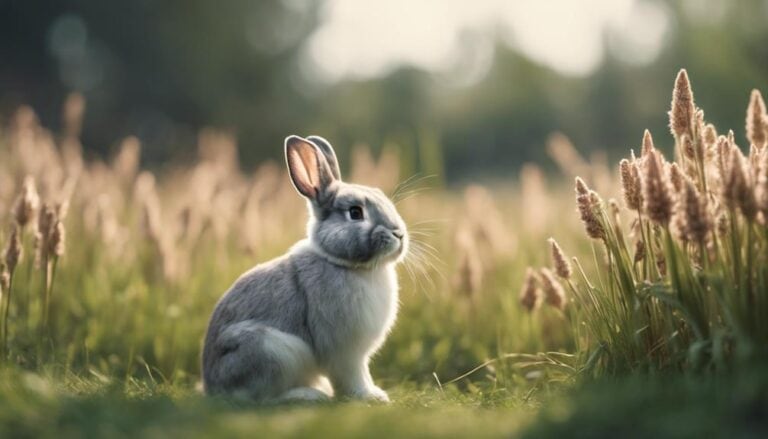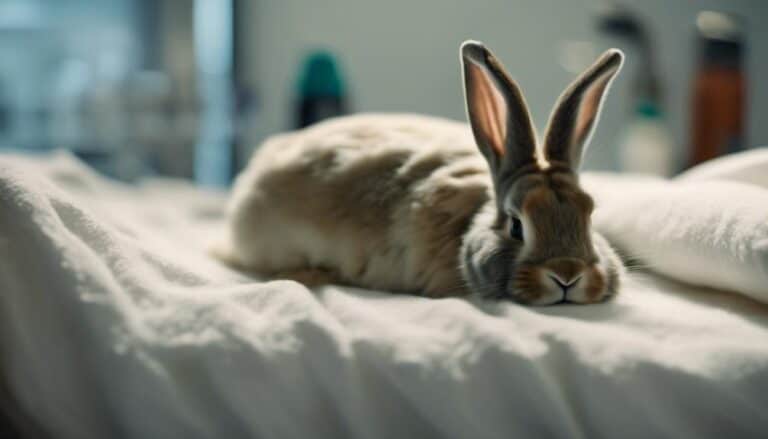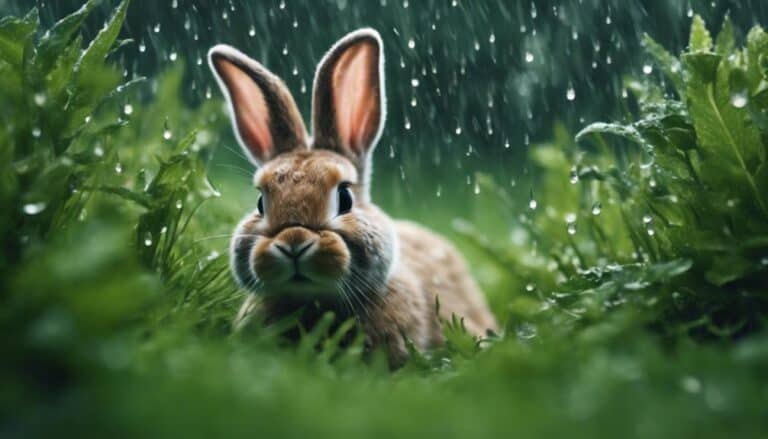If you've ever wondered if bunnies and guinea pigs can peacefully coexist, the answer might surprise you. While it may seem like a match made in furry heaven, the reality is a bit more complex.
Understanding their social dynamics, housing needs, and compatibility factors is essential. However, the key lies in how you navigate their behavioral differences, guarantee proper housing, and manage their dietary requirements.
But what about their medical considerations? Before you make a decision, there are important aspects to contemplate to guarantee a harmonious living arrangement for both species.
Contents
- 1 Key Takeaways
- 2 Social Dynamics of Bunnies and Guinea Pigs
- 3 Housing Needs for Bunnies and Guinea Pigs
- 4 Compatibility Factors to Consider
- 5 Introducing Bunnies and Guinea Pigs
- 6 Behavioral Differences to Watch For
- 7 Ensuring Proper Cage Size
- 8 Providing Companionship for Both
- 9 Managing Dietary Requirements
- 10 Medical Considerations for Coexistence
- 11 Frequently Asked Questions
- 12 Conclusion
Key Takeaways
- Guinea pigs and rabbits have different social dynamics and communication styles, requiring careful monitoring of interactions.
- Housing needs should be met separately to prevent conflicts, considering space requirements and species-specific behaviors.
- Managing dietary requirements and medical considerations is crucial to ensure the well-being of both species.
- Behavioral observations and environmental enrichment play key roles in promoting a harmonious cohabitation between bunnies and guinea pigs.
Social Dynamics of Bunnies and Guinea Pigs
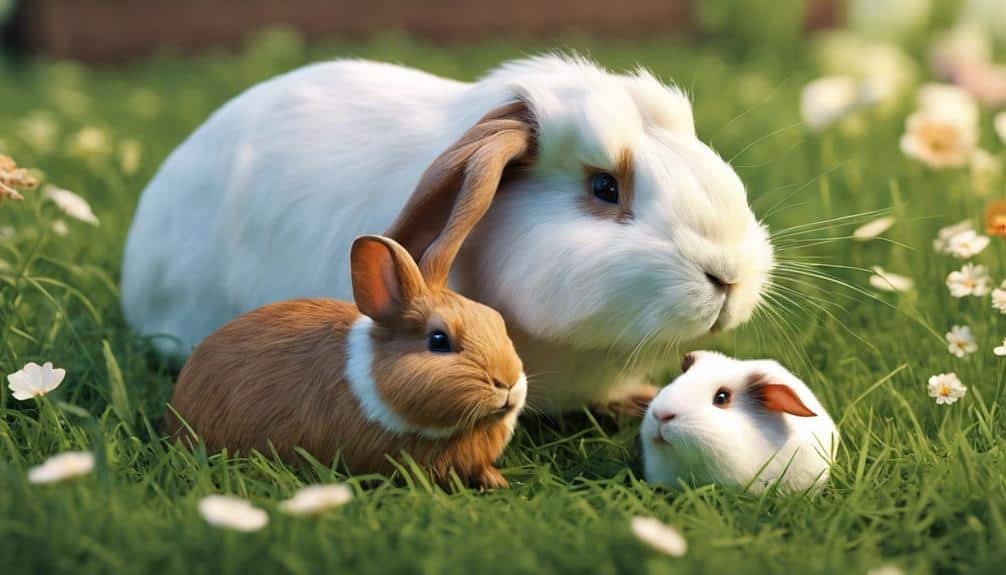
Understanding the social dynamics between bunnies and guinea pigs is pivotal for ensuring their harmonious cohabitation. Guinea pigs thrive in pairs or groups, while rabbits prefer bonded pairs or groups for companionship.
Communication styles vary between the two species, with guinea pigs vocalizing through purring and chirping, while rabbits rely on body language and scent marking within their group.
It's important to monitor interactions between rabbits and guinea pigs, as rabbits may display dominant behaviors that could lead to stress or conflicts within the shared living space. Establishing a hierarchy within the group can promote peaceful coexistence, allowing each animal to understand their place in the social structure.
Housing Needs for Bunnies and Guinea Pigs
To guarantee the well-being of both bunnies and guinea pigs, it's imperative to address their specific housing needs adequately. Guinea pigs need a minimum of 7.5 sq ft of space, while rabbits require at least 12 sq ft. It's recommended to provide a total of 14 sq ft to make sure both species have ample room for free movement. Adequate space in the enclosure is important to prevent stress and territorial behaviors between rabbits and guinea pigs. While it may seem appealing to house them together, separate housing is advised to avoid potential conflicts and injuries that may arise from cohabitation.
It is important to note that guinea pigs have specific nutritional needs that differ from rabbits. Guinea pigs require a diet high in vitamin C, which is essential for their health. When considering companionship for rabbits, another rabbit is usually the best companion due to their similar social behaviors and communication styles. If you do decide to house rabbits and guinea pigs together, supervision is vital to make sure their well-being and prevent any aggressive behavior that may occur.
Compatibility Factors to Consider

When considering compatibility between bunnies and guinea pigs, it's important to factor in their space requirements and social interactions.
Guinea pigs need hiding spaces to feel secure, while rabbits may exhibit territorial behaviors. Understanding these aspects can help create a harmonious living environment for both species.
Space Requirements
Consider the space requirements when planning to house rabbits and guinea pigs together to guarantee their comfort and well-being. Here are some key points to keep in mind:
- Rabbits need a minimum of 12 sq ft of space, while guinea pigs require at least 7.5 sq ft for adequate movement.
- Rabbits are larger than guinea pigs, with rabbits weighing over 10 pounds compared to guinea pigs' 2-3 pound weight.
- Providing a minimum of 14 sq ft of space is recommended for both animals to assure they've enough room to move freely.
Size and space disparities between rabbits and guinea pigs should be taken into account to create a harmonious living environment for both pets.
Social Interactions
When housing rabbits and guinea pigs together, understanding their social behaviors is essential for guaranteeing their well-being. Guinea pigs are social creatures that thrive in the company of their own kind, so the best companion for a guinea pig is another guinea pig.
Rabbits, on the other hand, can exhibit dominant behaviors and may bully guinea pigs if housed together. This can cause stress, injuries, and conflicts between the two species. To prevent such issues, it's recommended to provide separate living spaces for rabbits and guinea pigs, allowing each to interact with their own kind.
Introducing Bunnies and Guinea Pigs
To successfully introduce bunnies and guinea pigs, create a neutral environment for their initial interactions to prevent territorial disputes. Start by setting up a space that's new and unfamiliar to both pets. Here are some steps to follow:
- Gradual Introduction: Allow the animals to get acquainted through a barrier like a fence or cage before letting them interact directly.
- Close Monitoring: Supervise their interactions closely to guarantee they're getting along and there are no signs of aggression.
- Separate Resources: Provide hiding spots and separate feeding areas to reduce competition and stress between the guinea pigs and rabbits.
Behavioral Differences to Watch For
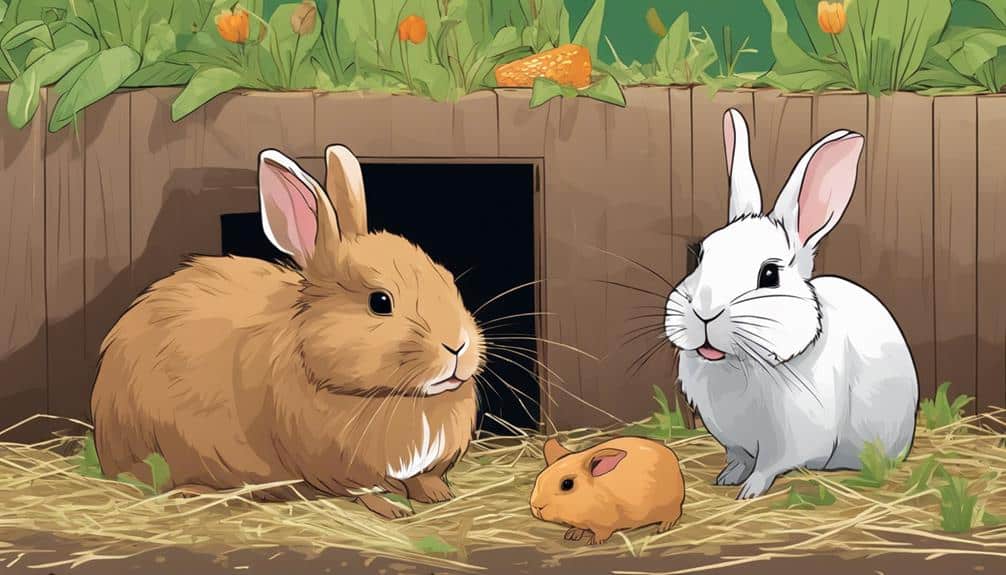
What behavioral differences should you be vigilant for when introducing bunnies and guinea pigs to live together? When combining rabbits and guinea pigs, it's important to be alert to certain behavioral variations that could impact their cohabitation. Here are some key differences to watch for:
| Behavioral Differences | Implications |
|---|---|
| Bullying behavior from rabbits towards guinea pigs | Can lead to stress and potential harm for the guinea pigs |
| Signs of frustration in guinea pigs due to communication differences with rabbits | May result in increased stress levels for the guinea pigs |
| Hiding behavior in guinea pigs in response to potential bullying by rabbits | Indicates stress and discomfort in the guinea pigs |
Additionally, be cautious of rabbits attempting to mate with guinea pigs, as this can cause physical harm. Moreover, staying vigilant for signs of respiratory infections is essential, as these can be transmitted between rabbits and guinea pigs when living together. By observing these behavioral cues, you can help guarantee a harmonious environment for both your rabbits and guinea pigs.
Ensuring Proper Cage Size
Ensuring the proper cage size for your rabbits and guinea pigs is crucial to promoting a harmonious living environment and preventing stress, injuries, and territorial conflicts between the two species. When setting up their living space, keep these key points in mind:
- Guinea pigs need at least 7.5 sq ft of space, while rabbits require at least 12 sq ft, with a recommended minimum of 14 sq ft for both for adequate movement.
- Rabbits are larger than guinea pigs and need more space to hop and exercise freely, ensuring their physical needs are met.
- Providing ample space in the cage or hutch can prevent stress, injuries, and territorial conflicts, fostering a peaceful cohabitation between rabbits and guinea pigs.
Providing Companionship for Both
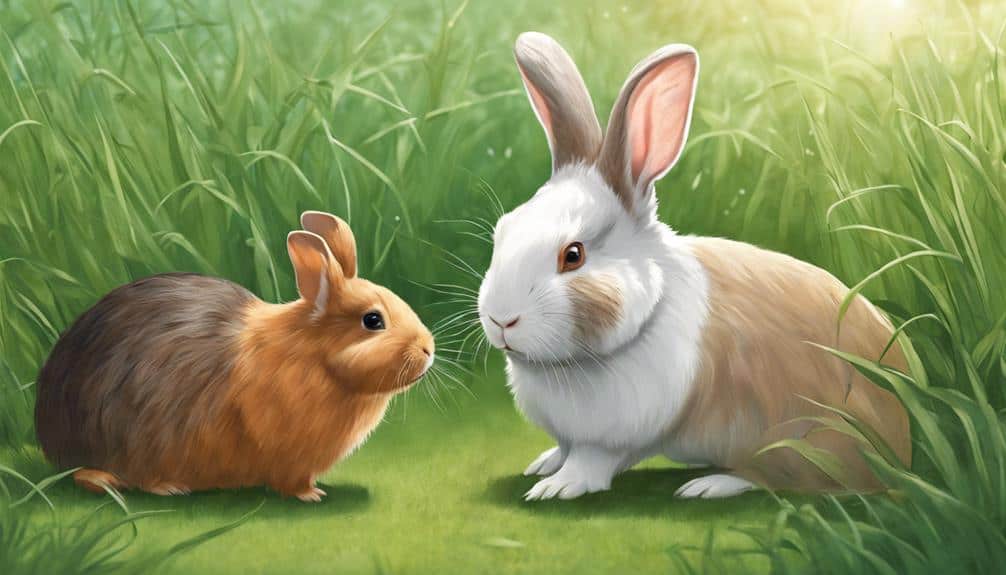
To guarantee the well-being of both your rabbits and guinea pigs, it's vital to contemplate their social interaction needs and compatibility factors. Guinea pigs flourish with companions of their kind, while rabbits benefit from bonded pairs or groups for adequate socialization.
Social Interaction Needs
When considering the social interaction needs of bunnies and guinea pigs, providing suitable companionship is essential for fostering their well-being and mental stimulation. It's important to understand the following:
- Guinea pigs: Guinea pigs require companions of their own species to thrive socially and emotionally.
- Rabbits: Rabbits benefit from living in bonded pairs or groups to prevent loneliness and promote mental stimulation.
- Overall: Ensuring that both guinea pigs and rabbits have suitable companionship enhances their quality of life and overall happiness. Meeting their social interaction needs is a fundamental aspect of caring for these animals and supporting their well-being.
Compatibility Factors
For ultimate well-being and harmony between bunnies and guinea pigs, one must carefully consider their compatibility factors when providing companionship for both species. Guinea pigs have specific needs, such as requiring Vitamin C in their diet, which rabbits do not need. When kept together, it is important to make sure that the guinea pigs receive adequate Vitamin C supplementation. However, housing these two species together can pose risks. Rabbits may bully guinea pigs, leading to stress and potential injury. Additionally, there is a risk of respiratory disease transmission between them. To promote a safe environment, it is essential to monitor their interactions closely and provide separate spaces if needed.
| Guinea Pigs | Needs |
|---|---|
| Vitamin C | Essential in diet |
| Housing | Monitor interactions |
| Health Risks | Respiratory disease transmission |
| Safety Measures | Provide separate spaces |
Managing Dietary Requirements
Managing the dietary needs of bunnies and guinea pigs is essential for their overall health and well-being. When keeping rabbits and guinea pigs together, it's important to be mindful of their specific dietary requirements to guarantee they thrive.
Here are some important points to contemplate:
- Vitamin C Requirement: Guinea pigs need Vitamin C in their diet to prevent scurvy, unlike rabbits who can produce their own. Ensuring your guinea pigs have adequate sources of Vitamin C is vital.
- Avoid Cross-Feeding: Rabbits shouldn't consume guinea pig food as it may not meet their specific nutritional needs. Providing each pet with their designated food will help prevent deficiencies.
- Separate Food Bowls: To prevent nutritional imbalances and guarantee each pet receives the right nutrients, it's important to have separate food bowls for rabbits and guinea pigs. This practice also helps in monitoring their individual intake and health.
Medical Considerations for Coexistence
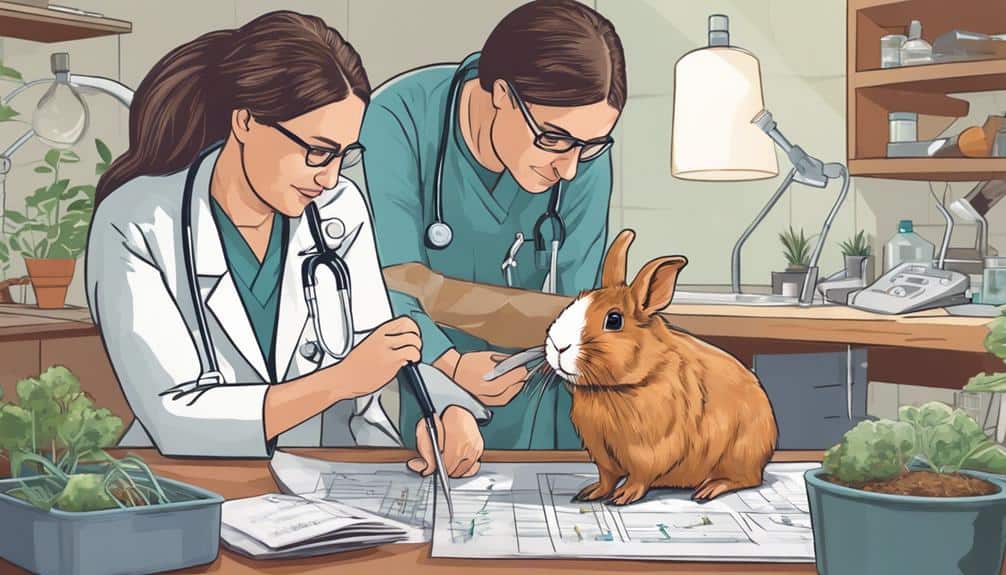
To guarantee the well-being of both your rabbits and guinea pigs when housing them together, it is imperative to take into account the medical aspects of their coexistence. Guinea pigs have specific dietary needs, requiring extra Vitamin C to prevent health issues like scurvy. Rabbits, on the other hand, can unintentionally harm guinea pigs due to their size and behaviors. Additionally, both rabbits and guinea pigs can transmit diseases to each other, posing potential health risks. Neutering rabbits is vital to prevent breeding and aggression towards guinea pigs. Medical considerations should be a top priority when deciding to house these animals together.
| Medical Considerations | Description | Importance |
|---|---|---|
| Vitamin C supplementation | Essential for guinea pigs to prevent scurvy | High |
| Disease transmission | Both rabbits and guinea pigs can transmit diseases to each other | Critical |
| Neutering rabbits | Crucial to prevent breeding and aggression towards guinea pigs | Important |
Frequently Asked Questions
Can You Keep Rabbits and Guinea Pigs in the Same Room?
You should keep rabbits and guinea pigs in separate living spaces within the same room to avoid potential conflicts. This guarantees pet compatibility, behavior management, and prevents stress or injuries. Provide ample space, supervision, and separate feeding areas for their well-being.
Why Can't Rabbits and Guinea Pigs Live Together?
Living together poses risks due to housing differences, social interactions, dietary needs, and compatibility concerns. Rabbits and guinea pigs communicate differently, have unique dietary requirements, and may harm each other. Safety and well-being are top priorities.
What Animals Can Rabbits Live With?
Rabbits can live with hamsters for companionship, but it's important to monitor their interactions. However, they should not cohabitate with cats, chickens, or dogs due to potential harm. Always prioritize your rabbits' safety and well-being.
How Do You Introduce a Rabbit to a Guinea Pig?
When introducing a rabbit to a guinea pig, start by placing them in adjacent enclosures. Swap bedding or toys to mix scents. After a few days, allow supervised meetings in a neutral zone, watching for stress or aggression. Provide separate spaces for eating and hiding.
Conclusion
To summarize, while bunnies and guinea pigs can live together, it's important to carefully consider their social dynamics, housing needs, compatibility factors, and behavioral differences.
By monitoring interactions, providing separate housing, and seeking advice from a vet, you can guarantee the well-being of both animals.
Remember, a harmonious coexistence between bunnies and guinea pigs requires attention to detail and proactive management.


